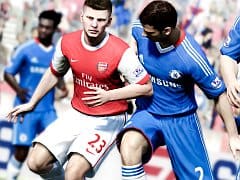Video Gamer is reader-supported. When you buy through links on our site, we may earn an affiliate commission. Prices subject to change. Learn more
EA Sports isn’t shy about bigging up FIFA 12. Straight off the bat at a recent presentation we were told this year’s instalment will be a revolution, not simply an evolution of previous titles. For a few years now, FIFA has seen incremental changes, tweaking what came before but not drastically changing the formula. You could buy a FIFA every couple of years and not miss out on much other than updated team and player rosters. This year it seems you’d be missing out big time.
You can read why I think FIFA 12 is going to be a revolution in more detail in my ‘Why FIFA 12 is a Revolution in Football Games‘ feature, but here I’m going to focus on what I consider to be the most significant change: physics.
FIFA 12 includes what EA Sports is calling the Impact Engine, another term for what everybody else would label “proper physics”. Whereas previous games looked great, close inspection revealed that collisions between players didn’t cut the mustard.
When players collided in FIFA 11, the game would determine which part of the body would cause the impact, and then choose an animation that suited. In some instances that would result in awkward animations and unnatural scenarios. The Impact Engine models every arm, leg, head, foot, knee, and torso so bodies interact with each other in a visibly realistic fashion.
Not only does this look incredibly lifelike, it serves to improve gameplay too. In FIFA 11 a tackled player would often go down under a challenge even if it wasn’t really hard enough to cause that effect. In FIFA 12 skilled players can come out of tackles in a variety of ways. A defender’s leg might clip Messi’s back foot but, because he’s good on his feet, he’s able to retain his balance and break free. In another scenario a player clumsily knocked a striker trying to hold up the ball, and the momentum made both fall to the ground.
EA demonstrated a particularly outrageous tackle that sent the player in possession spinning head over heels, but pointed out that this isn’t going to be a regular occurrence. The key thing is that EA Sports has finally got an engine with physics that match the impressive in-game models.
Now that EA is modelling collisions properly the game’s injury system has also been significantly improved. If a tackle looks like it’s going to damage a knee or ankle, it probably will. Players returning from injury need to be careful as they will be more likely to become injured if previously affected body parts are hurt. A particularly tired player can even injure himself by stretching for a ball, so it’s essential to build up a strong squad in order to minimise the effects of a long season.
We’ve yet to see what EA has up its sleeve with regard to the key game modes, but from a gameplay perspective the Impact Engine appears to be the biggest change FIFA has seen since EA’s series leapfrogged PES in 2007.
